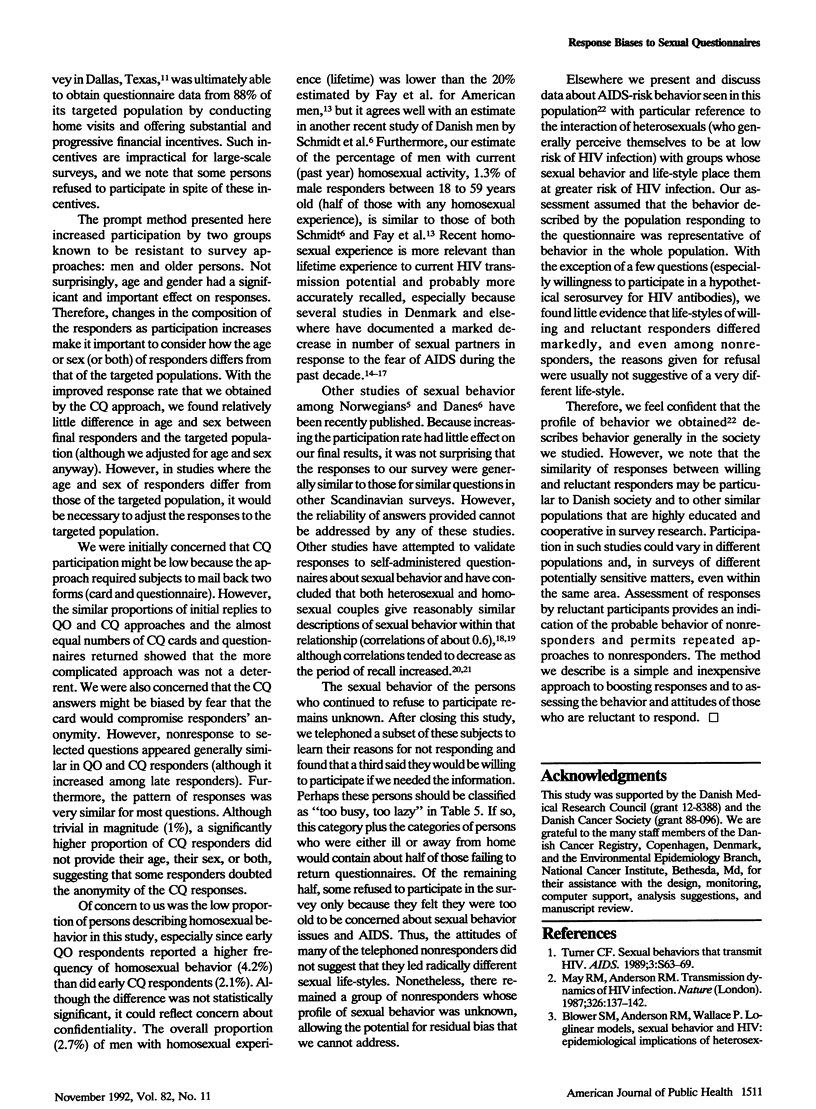Abstract
OBJECTIVES. Low response rates to voluntary surveys raise questions about how representative the responses are. We compared the behavior and attitudes of responders, willing and reluctant, and nonresponders to anonymous questionnaires about behaviors that might expose participants to the human immunodeficiency virus (HIV). METHODS. Questionnaires were sent to 1080 Danish adults 18 through 59 years including explicit questions about sexual acts and illegal drug use. Identical questionnaires were sent to 3600 other Danes, similarly chosen; packets sent to these persons included cards to be returned separately informing us that they had responded. Questionnaires were sent twice more to nonresponders, who, if they then responded, were considered reluctant responders. One hundred nonresponders were telephoned and asked why they had refused to respond. RESULTS. Enclosing return cards did not affect initial response rate, but prompting boosted replies from 52% to 73%. However, behaviors were generally similar among initial and reluctant responders. One third of nonresponders agreed to respond if we wished (total potential response: 82%). In general, the reasons for nonresponse did not suggest that the life-styles of nonresponders placed them at risk for HIV infection. CONCLUSIONS. This method provides a simple, inexpensive approach to improving response rates and learning about the biases of reluctant responders and nonresponders.
Full text
PDF






Selected References
These references are in PubMed. This may not be the complete list of references from this article.
- Coates R. A., Calzavara L. M., Soskolne C. L., Read S. E., Fanning M. M., Shepherd F. A., Klein M. H., Johnson J. K. Validity of sexual histories in a prospective study of male sexual contacts of men with AIDS or an AIDS-related condition. Am J Epidemiol. 1988 Oct;128(4):719–728. doi: 10.1093/oxfordjournals.aje.a115025. [DOI] [PubMed] [Google Scholar]
- Fay R. E., Turner C. F., Klassen A. D., Gagnon J. H. Prevalence and patterns of same-gender sexual contact among men. Science. 1989 Jan 20;243(4889):338–348. doi: 10.1126/science.2911744. [DOI] [PubMed] [Google Scholar]
- Johnson A. M., Wadsworth J., Elliott P., Prior L., Wallace P., Blower S., Webb N. L., Heald G. I., Miller D. L., Adler M. W. A pilot study of sexual lifestyle in a random sample of the population of Great Britain. AIDS. 1989 Mar;3(3):135–141. doi: 10.1097/00002030-198903000-00003. [DOI] [PubMed] [Google Scholar]
- Kjaer S. K., Engholm G., Teisen C., Haugaard B. J., Lynge E., Christensen R. B., Møller K. A., Jensen H., Poll P., Vestergaard B. F. Risk factors for cervical human papillomavirus and herpes simplex virus infections in Greenland and Denmark: a population-based study. Am J Epidemiol. 1990 Apr;131(4):669–682. doi: 10.1093/oxfordjournals.aje.a115551. [DOI] [PubMed] [Google Scholar]
- Levinger G. Systematic distortion in spouses' reports of preferred and actual sexual behavior. Sociometry. 1966 Sep;29(3):291–299. [PubMed] [Google Scholar]
- Martin J. L. The impact of AIDS on gay male sexual behavior patterns in New York City. Am J Public Health. 1987 May;77(5):578–581. doi: 10.2105/ajph.77.5.578. [DOI] [PMC free article] [PubMed] [Google Scholar]
- May R. M., Anderson R. M. Transmission dynamics of HIV infection. Nature. 1987 Mar 12;326(6109):137–142. doi: 10.1038/326137a0. [DOI] [PubMed] [Google Scholar]
- Melbye M., Biggar R. J. Interactions between persons at risk for AIDS and the general population in Denmark. Am J Epidemiol. 1992 Mar 15;135(6):593–602. doi: 10.1093/oxfordjournals.aje.a116338. [DOI] [PubMed] [Google Scholar]
- Saltzman S. P., Stoddard A. M., McCusker J., Moon M. W., Mayer K. H. Reliability of self-reported sexual behavior risk factors for HIV infection in homosexual men. Public Health Rep. 1987 Nov-Dec;102(6):692–697. [PMC free article] [PubMed] [Google Scholar]
- Schmidt K. W., Krasnik A., Brendstrup E., Zoffmann H., Larsen S. O. Occurrence of sexual behaviour related to the risk of HIV-infection. A survey among Danish men, 16-55 years of age. Dan Med Bull. 1989 Feb;36(1):84–88. [PubMed] [Google Scholar]
- Turner C. F. Research on sexual behaviors that transmit HIV: progress and problems. AIDS. 1989;3 (Suppl 1):S63–S69. doi: 10.1097/00002030-198901001-00010. [DOI] [PubMed] [Google Scholar]
- Wiktor S. Z., Biggar R. J., Melbye M., Ebbesen P., Colclough G., DiGioia R., Sanchez W. C., Grossman R. J., Goedert J. J. Effect of knowledge of human immunodeficiency virus infection status on sexual activity among homosexual men. J Acquir Immune Defic Syndr. 1990;3(1):62–68. [PubMed] [Google Scholar]
- Winkelstein W., Jr, Samuel M., Padian N. S., Wiley J. A., Lang W., Anderson R. E., Levy J. A. The San Francisco Men's Health Study: III. Reduction in human immunodeficiency virus transmission among homosexual/bisexual men, 1982-86. Am J Public Health. 1987 Jun;77(6):685–689. doi: 10.2105/ajph.77.6.685. [DOI] [PMC free article] [PubMed] [Google Scholar]
- van Griensven G. J., de Vroome E. M., Tielman R. A., Goudsmit J., de Wolf F., van der Noordaa J., Coutinho R. A. Effect of human immunodeficiency virus (HIV) antibody knowledge on high-risk sexual behavior with steady and nonsteady sexual partners among homosexual men. Am J Epidemiol. 1989 Mar;129(3):596–603. doi: 10.1093/oxfordjournals.aje.a115172. [DOI] [PubMed] [Google Scholar]


